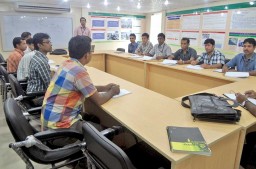
KDS Group, one of the biggest diversified corporations with interest in steel, real estate, IT, logistics, accessories and banking, is still passionate about its garment manufacturing facilities and has plans for putting up many more facilities. The company which was started in 1983 by Khalilur Rahman, in Chittagong has an annual capacity of 40 million pieces from a total 100 sewing lines consisting of 3600 sewing machines, making it one of the largest growing apparel manufacturer specializing in knitted tops and bottoms. Heading the Group’s apparel and textile division, Nitin Arora, Director, KDS Garments & Textiles, in conversation with Apparel Online shared the company’s plans for the future and recent developments.
The current turnover of KDS Garments & Textiles is US $ 150 million, out of which their 10 years’ old textile segment contributes about US $ 25 to 30 million, all of which is for captive consumption. “We are coming up with a new facility in an area near Chittagong called Kalughat where we will install about 1400 sewing machines. Being mass manufacturers for brands like Walmart, Marks & Spencer, Macy’s, Mothercare, Tesco and Target (US & Australia), the expansion is planned in the present product categories only,” says Nitin.
The major development at KDS has been the implementation of Lean manufacturing at one of its apparel manufacturing facilities, as part of the project undertaken by UK-based retailor George-ASDA. “Initiated in 2008, the project covered a total of 17 apparel manufacturing facilities throughout the country and KDS Garments registered the maximum improvements,” explains Nitin. The ‘Lean sewing floor’ of the company is different from a regular shop floor for it does not have any helpers. “The material flow is based on the principles of Just-In-Time, we have much smaller modular lines with pressing and packing at the end of the line, once the garment passes through needle detectors it is ready for dispatch,” proudly shared Nitin.
 The structure of the lines at the Lean floor is U-shaped with a lot of visual aids, Standard Operating Procedures (SOPs), individual buzzers for machine breakdown, with low in-line WIP and that too with just 21 machines per line. “Currently simple knitted products are taken on the line due to the initial learning curve, but we also plan to make swimwear and fleece products on these lines,” avers Nitin. Lean is a process necessitated because of high WIP, huge lines, unorganized operations, improper collection of production or shopfloor related data, negligible use of work-aids, time consuming methods for some tasks, and with rising labour wages and operating overheads coupled with reduced margins, Lean is not a choice but a necessity to sustain… “We were lucky to survive till now and I would advise other manufacturers to seriously start looking at Lean manufacturing,” he added further.
The structure of the lines at the Lean floor is U-shaped with a lot of visual aids, Standard Operating Procedures (SOPs), individual buzzers for machine breakdown, with low in-line WIP and that too with just 21 machines per line. “Currently simple knitted products are taken on the line due to the initial learning curve, but we also plan to make swimwear and fleece products on these lines,” avers Nitin. Lean is a process necessitated because of high WIP, huge lines, unorganized operations, improper collection of production or shopfloor related data, negligible use of work-aids, time consuming methods for some tasks, and with rising labour wages and operating overheads coupled with reduced margins, Lean is not a choice but a necessity to sustain… “We were lucky to survive till now and I would advise other manufacturers to seriously start looking at Lean manufacturing,” he added further.
[bleft]KDS is far ahead of many companies in the country boasting operator efficiencies of over 70% – double of the country’s average, 98% right first time percentage, improved pieces per worker from 36 to 50, reduced end line defects from 12% to 5% and reduced the throughput time from 550 minutes to 60 minutes. [/bleft]
KDS has implemented Lean on only one floor of its existing 4 factories, and would roll it out to other factories in 2-3 years to complete the whole project. “Due to the huge hours of training and re-training involved and as we are always gunning for shipments it is hard to find time to make changes. However, after successfully doing one complete floor with Lean, we now have a fair idea about what to do,” shares Nitin. The real struggle with Lean implementation is upgrading the skill of its workforce to be in sync with the new systems and SOPs, not because the workforce is not trainable but because the population of unskilled labour is too high, therefore it takes time to make changes. Despite all the bottlenecks, KDS is far ahead of many of the apparel manufacturers in the country due to its Lean implementation boasting operator efficiencies of over 70% – double of the country’s average, 98% right first time percentage, improved pieces per worker from 36 to 50, reduced end line defects from 12% to 5% and reduced the throughput time from 550 minutes to 60 minutes.








